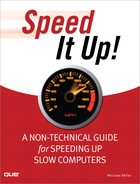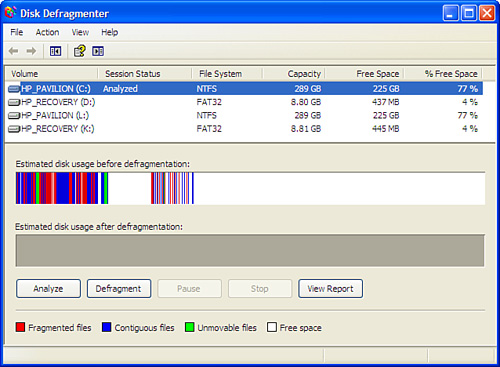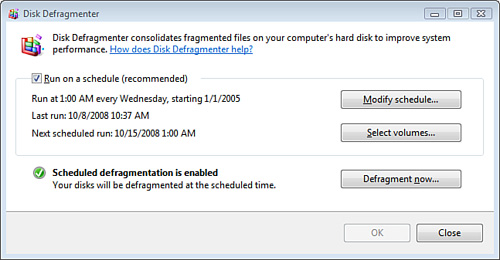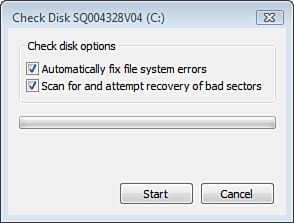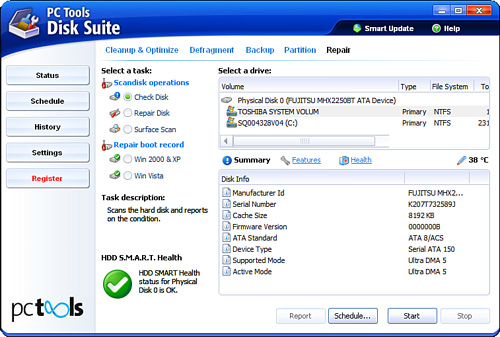Chapter 5. Optimizing Your Hard Disk
Your hard disk is a critical component of your computer system. Not only does the hard disk store all your program and document files, it also stores the Windows Registry (with all of Windows’ configuration settings) and the Windows operating system itself. As you’ve learned, it also serves as temporary virtual memory when what you need to do exceeds the capacity of your normal system memory.
Therefore, when your hard disk slows down, your entire PC slows down. That’s because your computer has to access your hard drive to retrieve those programs, documents, and configuration settings; we’re talking dozens of short accesses every minute. So the longer it takes for each hard drive access, even if we’re just talking milliseconds per access, the more your computer slows down.
It’s obvious, then, that anything you can do to speed up the performance of your hard drive makes your entire system go faster, as well. With that in mind, let’s look at some quick and simple ways you can speed things up by optimizing the performance of your computer’s hard disk drive.
When your hard drive starts to slow down, one of the most common culprits is a fragmented hard disk. That sounds worse than it is, although disk fragmentation can result in significant performance slowdowns.
Disk fragmentation occurs whenever Windows writes files to your hard drive. That’s because files aren’t saved as single entities. They’re broken into smaller chunks for easier handling, and each of these chunks is stored on a separate sector of your hard disk. Because each sector holds exactly 512 bytes of data, a large file could be stored in hundreds or even thousands of separate sectors—and not all together.
When a hard disk is fresh from the factory, all the sectors for a single file can be stored contiguously—that is, all in a row. This makes it easy for the read/write head of the hard disk to access the complete file. But as more files are stored to the hard disk, and as older files are erased, contiguous hard disk space might not be available when saving a new file.
When this happens, the chunks of the file are stored in whatever sectors are available—even if those sectors are widely separated on the hard disk. When a file is fragmented in this fashion, it takes more time for the hard disk’s read/write head to access each of the individual chunks and thus assemble the file for use.
It’s kind of like taking the pieces of a jigsaw puzzle and storing them in different boxes along with pieces from other puzzles. The more dispersed the pieces are, the longer it takes to put the puzzle together.
So if you notice your system takes longer and longer to open and close files or run applications, it’s because these file fragments are spread all over the place—in other words, your hard disk is overly fragmented. You fix this problem when you put all the pieces of the puzzle back in the right boxes, which you do by defragmenting your hard disk.
To improve the performance of your hard disk—that is, to reduce how long it takes to access a file—defragment the disk. This is accomplished by using the Disk Defragmenter utility built in to both Windows XP and Vista.
The Disk Defragmenter rearranges the chunks of data on your hard disk so that the data for a single file are stored in contiguous sectors—that is, all together in a row. To do this, the Disk Defragmenter has to temporarily store the data from noncontiguous sectors in system memory, erase those sectors to make room for new data, and then rewrite the stored data into new, contiguous sectors.
Tip
Windows’ Disk Defragmenter also rearranges where certain files are stored on the hard disk. Frequently used files are rewritten to the first sectors on the disk, where they can be accessed more quickly during normal use.
And this is how defragmenting your hard disk speeds up your PC. When necessary data is stored all together, it can be accessed much faster than if your system has to search all over your hard drive for all the assorted pieces and parts of the file. For an immediate speed boost, you can’t beat a simple disk defragmentation!
You use Windows’ Disk Defragmenter utility to defragment your PC’s hard drive. In Windows Vista, Disk Defragmenter runs in the background, automatically defragging your hard disk whenever your computer is turned on (and nothing else is going on). In Windows XP, however, you have to run Disk Defragmenter manually—which you should do at least once a month. (You can also run the utility manually in Windows Vista, if you like.)
To run Disk Defragmenter manually, follow these steps:
1. Click the Start button and select All Programs, Accessories, System Tools, Disk Defragmenter.
2. If you’re running Windows XP, you see the Disk Defragmenter window shown in Figure 5.1. Select your hard disk (typically drive C:) from the list in the top half of the window. You can then click the Analyze button to determine whether you need to defragment your hard drive, or just click the Defragment button to start the defragmenting process.
3. In Windows Vista, you see the Disk Defragmenter window shown in Figure 5.2. To defragment your hard disk now, click the Defragment Now button.
Defragmenting your drive can take awhile, especially if you have a large hard drive or your drive is really fragmented. So, you might want to start the utility and let it run over night or while you’re at lunch. But when it’s done, you should notice that your PC feels less sluggish.
Any time you run an application, move or delete a file, or accidentally turn the power off while the system is running, you run the risk of introducing errors to your hard disk. These errors can make it harder to open files, slow down your hard disk, or cause your system to freeze when you open or save a file or an application.
Fortunately, you can find and fix most of these errors directly from within Windows. All you have to do is run the built-in ScanDisk utility. This simple utility looks for and tries to fix errors on your hard drive—and thus speed up system performance in the process.
ScanDisk works like other similar “disk fix” utilities. In essence, it performs multiple tests of your hard drive’s integrity, and either points out or tries to fix any problems found.
ScanDisk starts by reading the data on your hard drive, sector by sector. If there’s a sector that it has trouble reading, ScanDisk attempts to move the data elsewhere, then marks that cluster as bad. Once an area is marked bad, Windows sidesteps it in the future—thus “fixing” your hard drive by disallowing access to bad sectors.
To use ScanDisk, follow these steps:
1. Click the Start button and select either Computer (Windows Vista) or My Computer (Windows XP).
2. From within Computer or My Computer, right-click the icon for the drive you want to scan, and then select the Properties option from the pop-up menu.
3. When the Properties dialog box appears, select the Tools tab.
4. Click the Check Now button in the Error-Checking section to display the Check Disk dialog box, shown in Figure 5.3.
5. Check both the options (Automatically Fix File System Errors and Scan for and Attempt Recovery of Bad Sectors).
6. Click Start.
Windows now scans your hard disk and attempts to fix any errors it encounters. If errors are found (and fixed), your PC’s performance should be enhanced.
Disk Defragmenter and ScanDisk are both built in to Windows and both are quite easy for anyone to use. But they’re not the only hard disk utilities available today. Several other companies offer tools to help you optimize your hard drive’s performance.
We’ll look at the most popular of these tools next.
Diskeeper is an automatic disk defragmenter that far exceeds Windows’ Disk Defragmenter utility. What makes Diskeeper unique is its InvisiTracking technology, which enables it to defragment your hard disk in real time. This ensures that your hard drive never becomes overly fragmented.
Several different versions of Diskeeper are available, with the Home version selling for $29.95. More information can be found at www.diskeeper.com.
Fix-It Utilities Professional is a collection of more than 40 different utilities designed to speed up your PC’s performance. It uses a wizard-based interface to perform various system-optimization routines.
The suite includes utilities for hard drive optimization and repair, disk defragmentation, startup optimization, disaster recovery, virus and spyware protection, file management, file recovery, secure file deletion, and more. It sells for $49.95. More information is available at www.avanquest.com.
Symantec’s Norton SystemWorks, or what used to be called Norton Utilities, is granddaddy of system utility programs. SystemWorks is a collection of utilities, each designed to monitor or repair a specific area of system performance.
SystemWorks is available in three editions: Basic ($49.99), Standard ($69.99), and Premier ($99.99). The Basic edition includes the following optimization utilities:
![]() CheckIt Diagnostics, which diagnoses hardware problems and helps to optimize memory use
CheckIt Diagnostics, which diagnoses hardware problems and helps to optimize memory use
![]() Norton Cleanup, which deletes unused programs and files from your hard drive
Norton Cleanup, which deletes unused programs and files from your hard drive
![]() Norton Disk Doctor, which detects and repairs various hard drive problems
Norton Disk Doctor, which detects and repairs various hard drive problems
![]() Norton Speed Disk, which defragments and reorganizes your hard disk
Norton Speed Disk, which defragments and reorganizes your hard disk
![]() Norton Startup Manager, which prevents the loading of unwanted applications on startup
Norton Startup Manager, which prevents the loading of unwanted applications on startup
![]() Norton WinDoctor, which cleans and repairs the Windows Registry
Norton WinDoctor, which cleans and repairs the Windows Registry
![]() Norton WipeInfo, which lets you permanently delete folders and files from your hard drive,
Norton WipeInfo, which lets you permanently delete folders and files from your hard drive,
![]() One-Button Checkup, which performs a combination of system scans at the touch of a single button
One-Button Checkup, which performs a combination of system scans at the touch of a single button
![]() Performance Test, which helps you benchmark the speed of your PC
Performance Test, which helps you benchmark the speed of your PC
![]() Process Viewer, which displays your system’s running processes and services
Process Viewer, which displays your system’s running processes and services
![]() System Optimizer, which enables you to customize hundreds of Windows settings
System Optimizer, which enables you to customize hundreds of Windows settings
The Standard edition includes additional performance-based utilities, and the Premier edition adds antivirus and antispyware protection. Learn more at www.symantec.com/norton/.
PC Tools Disk Suite is, as the name implies, a suite of disk management utilities. Included are utilities for file deletion/disk cleanup, disk defragmentation, Windows optimization, hard disk backup and restore, disk partitioning, and (most important) hard disk diagnostics and repair. The hard disk repair feature, shown in Figure 5.4, checks file system structure, scans the disk surface to find and repair bad sectors and disk errors, and displays various information about the status of the hard drive.
PC Tools Disk Suite sells for $39.95. More information is available at www.pctools.com/disk-suite/.
PerfectDisk is another freestanding disk defragmenter utility. This utility not only defragments your hard disk but also uses SMARTPlacement technology to place program files on your hard drive based on prior usage patterns. Several different versions of the utility are available; the lowest-priced Professional version sells for $39.99. More information can be found at www.raxco.com.
System Mechanic is a suite of utilities you can use to speed up and repair your computer system. It includes utilities for hard drive repair, Registry cleaning and repair, disk defragmenting, memory defragmenting, disk/file cleanup, secure file deletion, Windows configuration, hard drive diagnostics, and more.
System Mechanic is available on a subscription basis for $49.95/year. Learn more at www.iolo.com/system-mechanic/standard/.
Tip
In addition to these commercial utilities, many freeware and shareware utilities can help you optimize your system’s hard disk. In fact, the number of available software tools is too numerous to mention them all here. I recommend you go to the Tucows download site (www.tucows.com) and check out what’s available—many of which are completely free!
WinUtilities is a collection of tools for optimizing and speeding up your system’s performance. It includes utilities for disk/file cleaning, Registry cleaning, Registry backup and restore, startup cleaning, secure file deletion, memory optimization, Windows process/services management, and Windows setting management.
The WinUtilities suite sells for $49.99. Find out more at www.xp-tools.com/winutilities/.
Note
Sometimes even a properly running hard disk can be slow. This is because different hard disks rotate at different speeds. Most hard disks today rotate at 5400 revolutions per minute (RPM), although some older PCs (and even newer notebooks) move at a pokey 4200 RPM. For faster performance, upgrade to a 7200 RPM hard disk—as discussed in Chapter 11, “Adding More Disk Space.”
The more efficient your hard disk runs, the faster your PC. Here’s the bottom line:
![]() A fragmented hard disk takes longer to access programs and files. You defragment your hard drive using Windows’ Disk Defragmenter utility.
A fragmented hard disk takes longer to access programs and files. You defragment your hard drive using Windows’ Disk Defragmenter utility.
![]() Errors on a hard drive can slow down or even crash your system. You can find and repair hard disk errors with Windows’ ScanDisk utility.
Errors on a hard drive can slow down or even crash your system. You can find and repair hard disk errors with Windows’ ScanDisk utility.
![]() Utilities from other companies can also help you defragment and optimize your hard disk, as well as improve system performance in other ways.
Utilities from other companies can also help you defragment and optimize your hard disk, as well as improve system performance in other ways.
